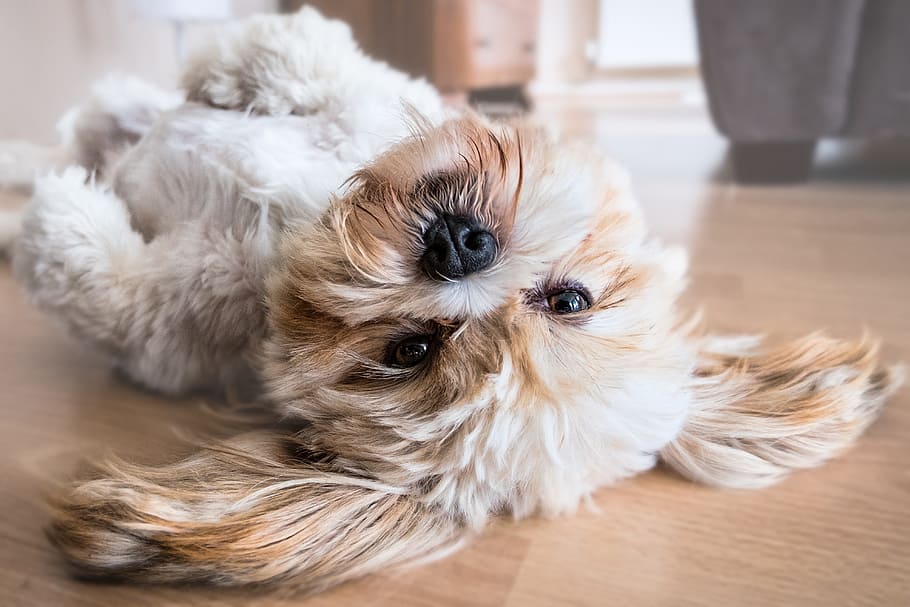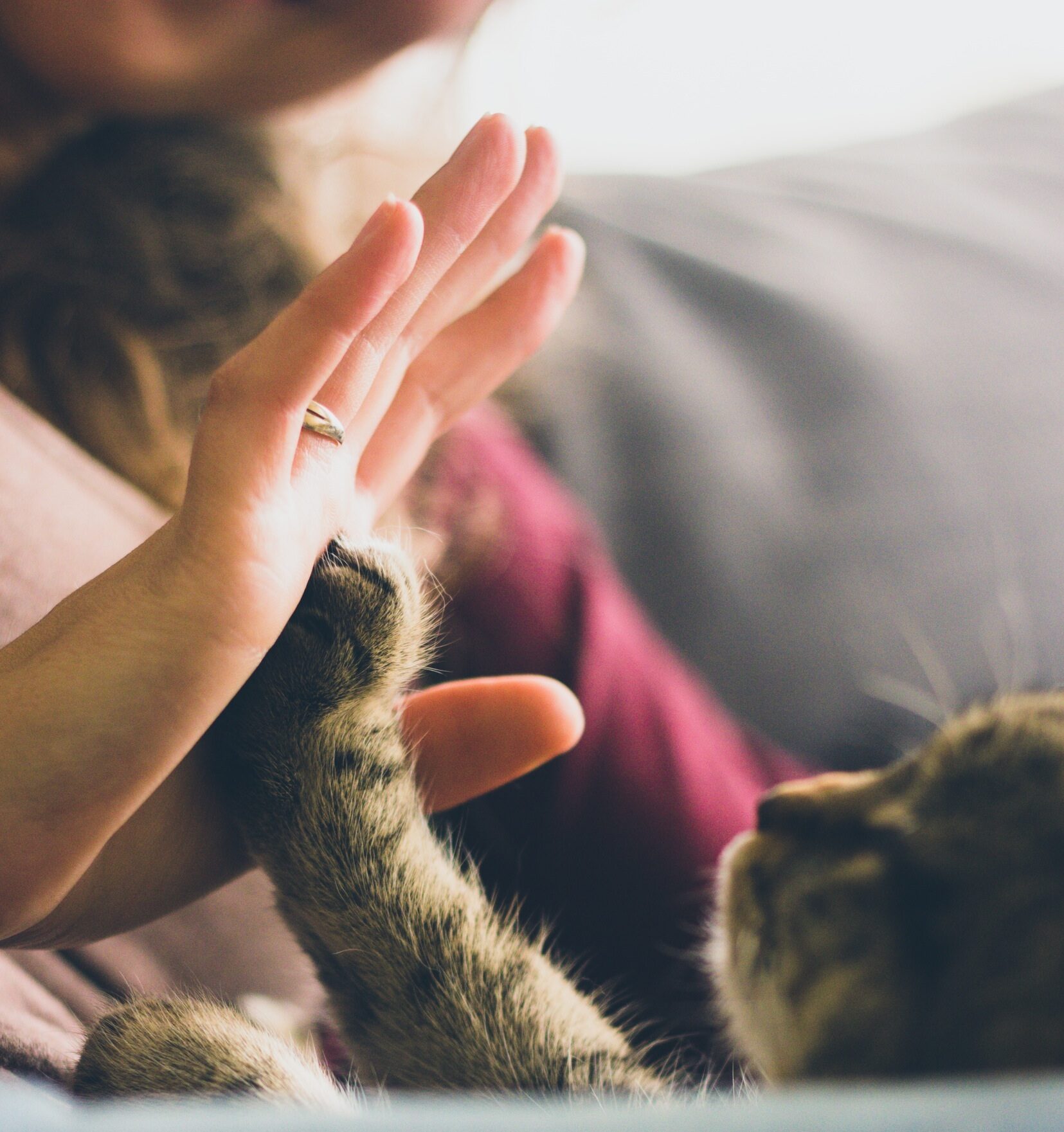Is this familiar?
You’ve been training tricks with your dog, and want to impress some visiting friends with his new skills.
You ask him for a high five.
He gives a high five, then he lies down, plays dead, rolls over… all the while throwing expectant looks at you, as if saying “is it this?!”

In other words, you ask for one specific behaviour, and he enthusiastically responds by giving you his entire learned repertoire of tricks.
What’s going on?
Well, in technical terms, he’s not under Stimulus Control.
In less technical terms, he hasn’t yet quite learned about cues.
Learning cues is difficult for animals.
We often underestimate the difficulty involved when animals learn to respond correctly to cues.
If you’re new to the concept of cued responses, it’s about the animal doing a specific behaviour when asked.
Sitting when you ask him to sit.
Coming when you call his name.
Waving a paw when you say “high five!”
That is, showing a specific response, corresponding to a specific signal from the trainer or environment. Part of understanding cues is also not waving a paw when you ask him to sit.
What’s so difficult about that, you may ask.
Well, it’s a two-step process:
- He needs to figure out that a certain behaviour pays off in the current context. For instance, that waving the left paw produces cookies, or that coming up to a person leads to getting a good scratch in just the right spot.
- Once that’s accomplished, he needs to figure out what it is about the context that let him know that a particular behaviour pays off right now. That is, it’s when mommy says “high five!” that waving the paw produces cookies – not when she’s silent, or when she says “roll over!”
In other words, if guests applaud, or you laugh, give eye contact, a cuddle, or indeed cookies after your dog does his little improvised performance, you’re training him to ignore your cues.
You’re teaching him that “when mommy looks expectantly at me and makes a noise, if I then show off some of my learned trick behaviours, good things will happen”.
And maybe that’s fine. After all, the guests are happy and your dog is happy.
But maybe, for some reason, you need the dog to respond to the cue with the correct behaviour – not just any random behaviour, or the whole repertoire.
Maybe you need a rock solid recall, even in distracting environments.

How to teach a cue.
Here’s the main outline of teaching the animal a cue (this list is not written in stone but may be changed depending on circumstances):
- train the response
- add the cue
- discriminate
- probe
- generalize
- trick / alternate
I’m sharing a video illustrating this from my online course Getting Behaviour – the Foundations of Animal Training. For reference, we’re in module 5, all about cues, and this is chapter 4.
Åsa filmed all her training and edited out the breaks, so there’s no further training than what you see here. However, the dog is really clicker savvy and understands several other cues already – that makes a huge difference.
Previous students pointed out that I was a bit unclear as to what a probe is.
It’s giving the cue in a new context. Like when Åsa lay down the mat in the garage. Responding to the cue in a new context is difficult since it implies both discrimination (recognizing the cue as a relevant stimulus in relation to other stimuli) and generalization (responding to that cue in a completely new stimulus situation).
So, probing could be using the cue in a context where it was never used before (outdoor if trained indoors), tricking is testing it with similar nonsense-cues and generalization gradually adding more and more distractions and difficulty.
Here’s a very nice twist on adding the cue that reduces the potential frustration of the animal: having a default behaviour that the animal can fall back to, that you can reinforce by presenting the cue. Read Alexandra Kurland’s blog post here.
Achieving stimulus control
As you’re adding more distractions and generalizing to new situations, the animal should become gradually more fluent (accurate and consistent) in responding correctly to the new cue.
When you bring a response under stimulus control, you teach the animal to discriminate and generalize. You aim for high fluency and low latency, and some or all of the following criteria:
- the animal waits for the new cue – he’s no longer showing non-cued responses
- when the new cue is presented, the animal responds promptly
- the animal shows the unique response corresponding to the specific new cue, not some other response
- the animal doesn’t show that response to some other cue
Hopefully, these ideas might help clear up your cues, and bring better clarity for your animal!
***
I teach animal lovers how to get happy animals who are reasonably well behaved. Interested in learning more? Sign up below to get notified whenever I publish a new blog post, give free webinars, mini-courses or Masterclasses, run silly little experiments – or whenever one of my big courses are open for admission! I go into more detail about cues in the full Getting Behaviour course – find it here.
11 replies on “How to teach a cue”
[…] A verbal “come!” would be the SD telling the animal that if he runs up to the person, he’s going to get a treat. Or the presence of a chicken on the kitchen counter might be the SD that triggers counter surfing behaviour. If you’re having trouble with cues, here’s how to teach ‘em. […]
This is a great step by step example of teaching and proofing a cue. I was taught to get the behavior fluent before putting a cue on it, but it is hard to get my students who are just learning to do this. I think this will help me explain it better. And I really enjoyed Alexandra’s article. I love the ‘grown up’ cue 🙂
Glad to hear it’s useful! 🙂
So interesting ! Just a question (or two).
What is the ultimate goal ? That a verbal only cue, or a visual only cue, elicits the behaviour ? Or, … ?
Ex: Because it was supposed to increase our ‘bond’, I started asking Kuda (dog) to sit (both verbal and/or signal) before I would put her food down for her. Now, when Kuda sees me carrying her food bowl, and she’s interested, she offers me a “sit” – wherever she is and can see me Hahaha. Is this basically in line with the sequence ?
Why was it a mistake to give the cue after the behaviour change had started ?
Was Midore asked to stop halfway to target ?
In the video, the target stayed the same (blue thing) for the “target” cue, i.e. to teach a “place”, use a different target (e.g. blanket), or use the same (blue thing) ?
Really liked the 3 Cs of clicker training. I don’t use a clicker, I use a word to mark but they still apply, yes ? Communication, Choice, Connection …
Thank you !
P.S. I was also taught not to use dog’s name often = keeps the name worthy of attention.
The ultimate goal would be a reliable response to the cue – and the cue might be verbal or visual – or both! Trainer’s decision. 🙂
I think the sit is perhaps not such a good example of a behaviour where we might achieve solid stimulus control, since many dogs sit many times during the day,and for many it’s a default behaviour that they revert to when perhaps they don’t know what to do – and they use it as a way to communicate when they want something. Go sit in front of mom, and I’ll get eye contact, attention, petting, being let out, a play session, or food…
Giving the cue after the behaviour chain started makes it less noticeable for the animal (the behaviour might overshadow the cue), and in classical conditioning, the intended conditioned stimulus (the cue) must start before the unconditioned response (the behaviour being taught) in order for optimal learning to occur.
To teach a location I might start with the blue thing and gradually fade it. Here, the blue thing was moved to teach the dog that the desired behaviour was NOT going to a specific location but the actual target..! 🙂
I would only change one thing. You recommend, “Coming when you call his name.” Which is one of the ways that come is taught. I was initially taught to preface every cue with his name. The reason being hearing his name informed him what I said next was intended for him. It also ensured that the cue could be mixed in a conversation. For example, I am asked what my dog’s name is. I say, “Jack”. Jack comes or my friend named Jack comes down the street unexpectedly and I call out, “Jack over here.” and Jack comes. In both cases, I should interrupt my exchange with whoever I am talking to and praise/reward Jack.
Ah, yes, great point – the recall cue should not be solely a name, indeed, it doesn’t have to involve naming at all – as long as it’s a unique cue, any stimulus works! 🙂
Thank you for this text and the video!
It makes things more clear 🙂
🙂
I love these steps in training. You really give yourself time to reflect even better if you write down your progress. If I do it every time? No. I forget very often. My dogs are som forgiving. But I definitely see the difference in our training if I follow these steps. I also add latens in to the work. How fast the dog react after given the cue.
Good point – looking at the latency is part of achieving stimulus control, for sure! 🙂